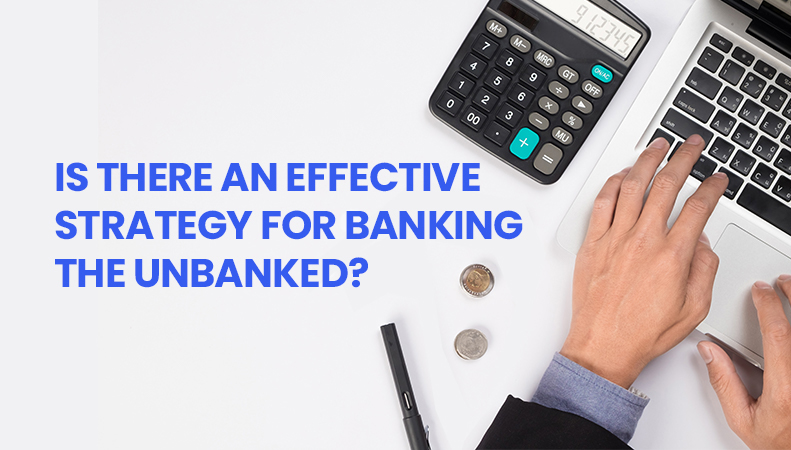
IS THERE AN EFFECTIVE STRATEGY FOR BANKING THE UNBANKED?
27th December 2021
Adults who never use banks or banking institutions in any form are referred to as "unbanked." Unbanked and underbanked populations are usually paid in cash or use money orders or prepaid debit cards to make purchases. Unbanked people are also less likely to have insurance, pensions, or other professional money-management services. Alternative financial services, such as cheque cashing and payday lending, when available, they would make use of them. Extremely impoverished people may also have little need for the banking system as they strive to make ends meet. They find themselves unable to keep minimum balances, pay account fees, or even organise transportation to and from bank branches during business hours.
The most common reason for not having a bank account is, at least in part, a fear of the costs that come with them. The expenses of remaining unbanked, on the other hand, usually outweigh the costs of bank fees. Alternative financial product fees, on the other hand, are frequently displayed—even if they are not transparent. When you enter into a cheque-cashing store, for example, the menu of services and their (initial) charges are frequently shown on the wall. Getting a money order at a grocery shop or other retail location, for example, has a clearly stated cost. Bank fees, on the other hand, are far nebulous.
To stay up with the "no-touch" method of working, many firms had to go through a digital transformation. Consumers benefited from significant technical disruptions that enabled financial inclusion and payment digitisation. With businesses moving online, many end-users began using digital payments to pay bills for the first time, pushing the total number of digital payments completed globally in 2020 to a staggering 70.3 billion!
While the information on monthly maintenance fees, overdraft fees, minimum balances, and ATM fees is available online (assuming a potential customer has good internet access), each bank's website places these details in different locations, making it more difficult to determine what to expect from any institution or account. Alternatively, potential customers can request a pamphlet describing the details of an account at a bank branch, but they will most likely have to read the fine print to figure out the cost structure. The disparities between the publicly displayed (but incomplete) costs at alternative financial services providers and the difficult-to-find fees at banks make the choice easy for people who worry they don't have enough money to make a bank worthwhile, and for those who distrust banks.
Reasons why people are unbanked
1. Poor Credit History
Many banking products, such as overdrafts and credit cards, have a borrowing component. If a person has a low credit score, their access to such banking products will be limited. If a person has missed payments on loans or credit cards, they may have a negative credit history. Additionally, persons who are new to banking may not have a sufficient credit history to be provided with certain products and benefits.
2. Lack of Trust in Mainstream Banking
Many consumers still have a negative perception of financial institutions and are unsure that they will look after their money. Some people believe that the fees charged by banks are excessive, so they opt out of the mainstream banking system.
3. Convenience and Access
Several people's banking options have been constrained because of many banks closing branches in rural locations. Although many customers have welcomed internet banking, others, particularly the elderly, lack computer literacy and hence have been unable to obtain the items they desire. Even in places with enough high street bank branches, many people are underbanked since branch hours are inconvenient for them.
4. Problems with Language and Literacy
A huge proportion of unbanked people struggle to understand the jargon and varied words linked with different banking products. This implies people are hesitant to invest in specific goods or even seek advice from bank employees.
In other circumstances, migrant workers and persons who have migrated to the UK from other countries do not speak English well enough to convey their financial needs, and most banks do not provide translation services. As a result, they become underbanked.
5. Unemployed or Lack of Steady Income
For many migrants and lower income groups, financial services might be considered too expensive, especially services available in conventional financial institutions. There are various fees to settle, minimum deposit requirements to meet and other upfront costs that constantly deter unbanked individuals with unstable revenue streams from even considering these services.
6. Bankruptcy
People who have been declared bankrupt may be unable to create a new bank account until all outstanding debts have been paid or their assets have been unfrozen.
An Effective Strategy for Banking The Unbanked
1. Eliminate Barriers
The majority of unbanked people in developing or developed nations feel it is difficult to create a savings account with a traditional financial institution. True, some banks demand fees that make maintaining an account financially difficult. In rare situations, a bank may set account minimums that are difficult to meet for those with modest earnings.
If you want to reach out to the unbanked, the first step is to remove the obstacles in their way. Monthly account fees, minimum balance requirements, and other restrictions, such as requiring an account holder to receive direct deposit, are examples of such requirements. People frequently open a bank account when they start a job that pays via direct deposit, only to close it later if they lose their employment or the source of the transfer.
2. Create Mobile Apps
The advent of mobile internet has resulted in a decrease in the use of residential broadband. As income levels fall, the percentage of homes with a high-speed home internet connection decreases. Because people in these segments are more likely to be unbanked or underbanked, the number of unbanked people who rely on a mobile device rather than a home internet connection is likely to be large. If you want to make your bank's services more accessible and convenient for unbanked or underbanked people, you should start thinking mobile-first. Along with establishing mobile apps that allow users to access their account information, you should also focus on creating apps with a lot of features. People should be able to use a mobile banking app to move money between accounts, pay bills, and deposit paper cheques.
3. Decrease Reliance on Physical Branches
It's also beneficial to shift your focus away from traditional branches, in addition to mobile banking. Certain actions, such as opening an account, are only available in person at some financial institutions. Individuals are more likely to seek similar services from companies that are more convenient to them if banking hours and locations are inconvenient. Finding techniques to authenticate identities, such as biometrics or two-factor authentication, might allow a financial institution to deliver services that were previously only available on-site online or through a mobile app.
4. Enable the Unbanked with Prepaid Offers
Debit cards are one of the biggest potential drivers of financial inclusion in Malaysia, which essentially works to improve payment accessibility for individuals nationwide. It's easy to pay for products or services quickly and efficiently with debit cards. In fact, Malaysia has approximately 19.2 million 'active' cards-in-circulation which comprises almost the full bankable population of approximately 20.4 million adults. But what about the unbanked?
Fortunately unbanked individuals have the option of leveraging on prepaid cards which work almost exactly like debit cards. The main difference is that prepaid cards are not linked to bank accounts. Instead, prepaid cards rely on stored monetary value within the cards themselves, meaning that cash is loaded onto the card beforehand. It's generally safer than carrying cash, and spending limits based on how much is loaded onto the card can help with financial management. Prepaid cards can also be an effective technique to persuade people who are currently unbanked to start leveraging on innovative services.
5. Create Financial Education Opportunities
Another key reason why people do not have accounts or do not use bank services is a lack of faith in banks. Creating educational opportunities for consumers is one method to develop a sense of trust in them. Short video tutorials on topics, like saving money, applying for credit, and opening a savings account can be created by a bank. The videos may be accessed via a mobile website or an app provided by the banks. Virtual assistants that answer financial queries or provide information and direction to unbanked customers might help a bank create trust with them.
6. Expand Credit and Loan Options
When analyzing an individual's creditworthiness, one option is to use non-traditional payment data, such as on-time rent and energy payments. Another alternative is to make credit-building loan choices such as secured credit cards or credit-builder personal loans more accessible to individuals. It's also conceivable to start offering peer-to-peer lending or crowdfunding to formerly underserved customers using technology.
Options for Paying Employees Who Do Not Have a Bank Account
1. Manual Paychecks
Pros:
- Employers have a paper trail (unlike when you pay them with cash).
- Employees get a pay stub.
- Employees don’t need a bank account or direct deposit.
Cons:
- Employees need to pay fees to cash the checks.
- Employers need to get them printed or mailed, which requires special equipment if done in-house and takes time.
2. Prepaid Cards
Pros:
- Employers can transfer their employees' earnings directly into their cards.
- Employees may use the cards in stores, online, and at ATMs just like a debit card.
- The money is available to employees right away.
- They can be quite cost-effective and include fraud prevention.
Cons:
Prepaid cards might impose a variety of "junk" or hidden costs, depending on the provider, such as
for participating in the program, checking card balances, withdrawing money, having a low balance,
overdraft, and so on.
3. Cash
While paying with cash may seem appealing since it appears to take out the middleman, it's a payroll no-no for various reasons. Because neither the employer nor the employee receives a paper trail, paying with cash is a particularly dangerous transaction. In other words, it's far more difficult to stay compliant, it makes the LHDN suspicious, and it makes it difficult to show any form of fraud when things go wrong. Cash isn't a handy or secure payment method for employees, as we've already mentioned, and responsible employers should help their employees with access to a secure salary payout system.
Evolet can help with the efficient adoption of payment and salary payout systemization through digital means. With a vast array of features and capabilities to improve the financial wellbeing of migrant workers and other sectors of the unbanked, Evolet relies on state-of-the-art applications that enable employers to manage various financial processes safely, quickly and easily while catering to an inclusive workforce.
EVOLET is a digital wallet app for migrant workers.
Learn more at https://evolet.io/
